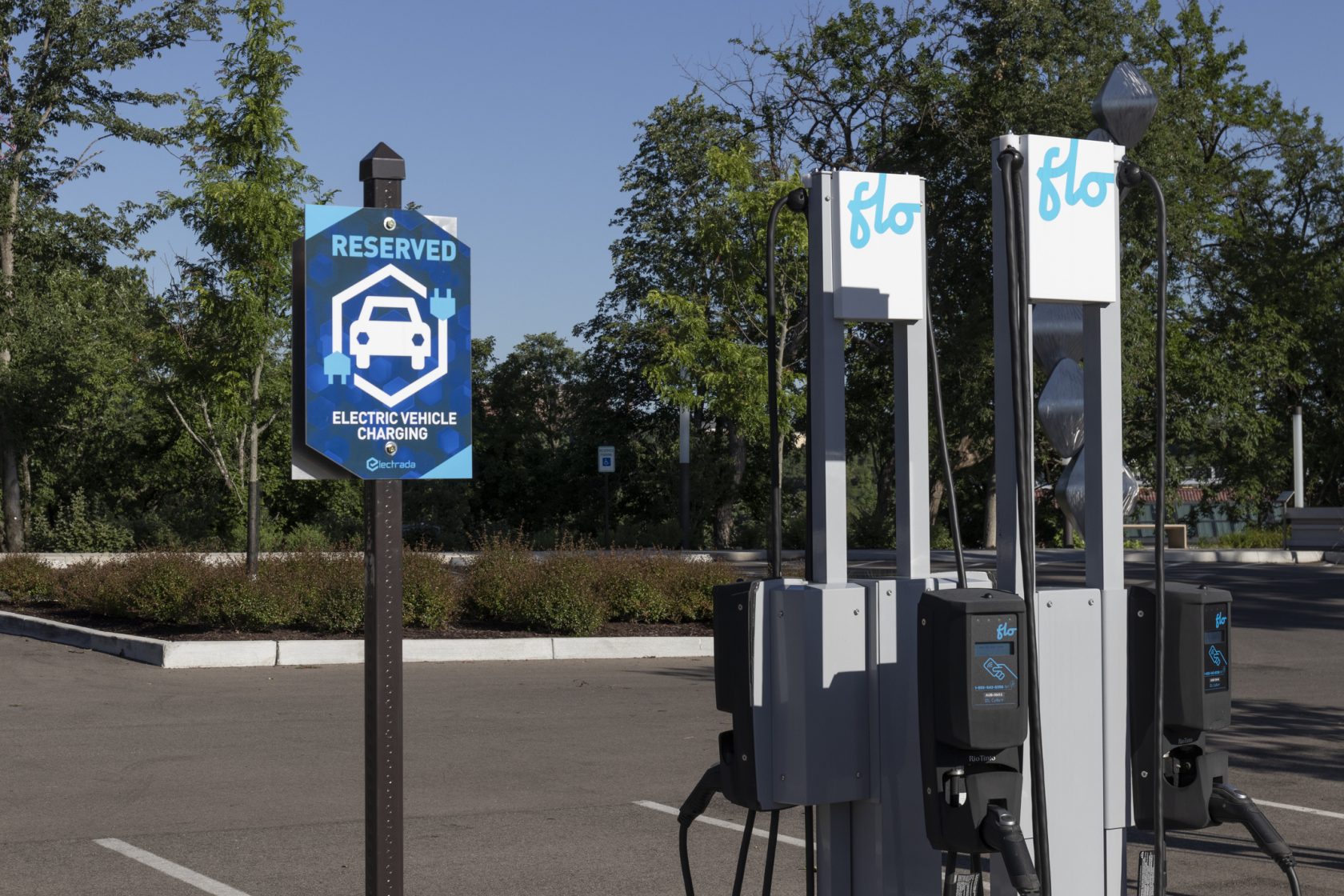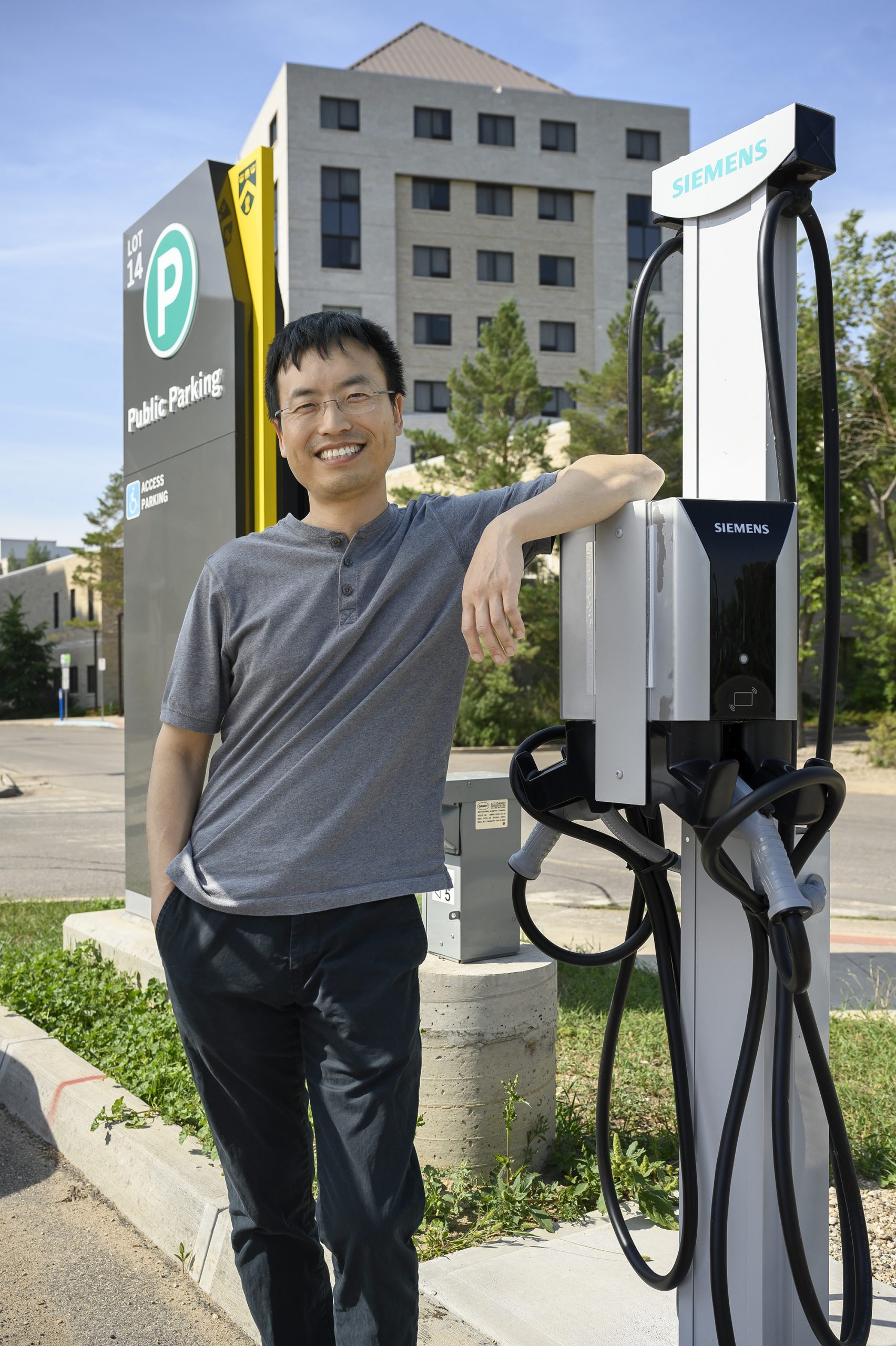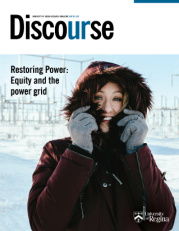Mapping EV infrastructure to meet drivers’ needs, achieve emissions target.

When Victoria Martinez and her young family rolled into Davidson to charge up their 2020 Hyundai Ioniq on the Canada Day long weekend, what has typically been a 45-minute battery top-up turned into a nearly three-hour long exercise in frustration.
Martinez and her partner usually plug into the town’s free Level 2 (L2) charger, then walk over to browse the stacks at the regional public library or shop for treasures at the Field’s store. But this trip they decided to try out the new Flo fast charger a short distance outside Davidson. The L3 port on their electric vehicle (EV) wouldn’t play nice with the charger, which led to a few hours of ultimately unsuccessful troubleshooting with the company’s customer support line.
“Four or five families used the Tesla charger in the time I was troubleshooting at the Flo station,” says Martinez. On top of that, she discovered that, unlike gas pumps which accept debit cards and most major credit cards, Flo chargers require preloaded payment cards.
The family’s relatively minor road trip hiccup is one example of the growing pains that are bound to come with the transition away from gas-powered travel to clean, green energy.
Transportation currently accounts for around a quarter of Canada’s greenhouse gas emissions. The Federal government has set a target that all car and passenger trucks sold in Canada be zero-emissions vehicles by 2035. But the spotty availability of charging stations is a major roadblock to reaching that destination – particularly on the prairies which are home to less than 6 per cent of all of this country’s chargers.
In addition to worrying about whether they have enough juice to make it to the next charging station during long-distance trips – so-called “range anxiety” – drivers are also concerned about the potential for long waits at charging stations and the fact that cold weather and strong winds – conditions not unheard of in some parts of Canada, especially the prairies – are an additional drain on EV batteries.
Now a research team led by professors at the University of Regina is drafting a roadmap that can inform and guide decisions about the EV infrastructure that will be required to support a net-zero transportation sector. A diverse group of researchers from the U of R’s Faculties of Engineering and Applied Science, and Business Administration – with expertise in transportation, smart grids, operations research, and renewable energy – will be working alongside specialists from SaskPower, the City of Regina, and Acuere Consulting Inc, an engineering consultancy. The work is supported by a three-year, $707,600 Alliance Missions Grant from the Natural Sciences and Engineering Research Council of Canada (NSERC).

With data provided by SaskPower and the City of Regina, the team will be investigating current traffic volumes and patterns to forecast demand for charging and how battery power will be consumed. They’ll be working to develop tools to help determine where charging stations should be located to support long-distance, east-west travel across Canada – by not only passenger vehicles but also commercial cargo trucks. The team also wants to provide guidance on where to locate chargers in urban settings to prevent long lineups and congestion. Their aim is to create models that planners in government, municipalities, and utilities can use to anticipate charging needs down the road.
“This shift will require a mutual effort, not only for drivers who are going to buy electric vehicles, but also from various sectors – such as electricity – to provide good infrastructure, to support sustainable growth in transportation,” says research lead Dr. Yili (Kelly) Tang, an adjunct professor at the University of Regina specializing in transportation and human mobility. “Our ultimate, shared goal is to reduce emissions, to have a better society, and a more sustainable future.”
More EVs means more demand for electricity
Shifting gears from internal combustion engines to electric motors will significantly reduce both climate pollution and total energy required, thanks to the much higher efficiency of EVs. But an all-in switch to EVs will require electricity – lots of it. “We have to prepare our power system very well in order to cope with a high penetration of electric vehicles,” says Dr. Zhanle (Gerald) Wang, an assistant professor of electrical systems engineering at the U of R. “It’s not currently designed to include those.”
Take residential users. Electricity demand for the average household is in the neighborhood of 1 to 1.5 kilowatts, with higher demand when cooking with an oven or running a clothes dryer. But a L1 charger on a standard 120V outlet can easily double that average. Put an L2 in your garage and that number can bump up the demand to 6-7 kilowatts, similar to a clothes dryer, or as high as 19.2 kilowatts on a dedicated 100 amp circuit.
“If we want EV usage to take off, we have to ensure our power system can handle home charging, plus the load placed on it by commercial charging stations in urban areas and along our highway networks.”
“Without changes, that kind of increase in demand could overload the existing power grid,” says Dr. Wang. “We need to look at how EV charging impacts the power system. We need to think about transformer loading. Right now, most cities have one transformer for multiple houses. But if all of those houses have an EV charger, then the transformer can be overloaded.”
To manage this increasing demand on electrical grids, utilities in some jurisdictions have already started implementing dynamic pricing models that incentivize EV owners to plug in at home during off-peak hours, for example between midnight and 8 am. Wang says that by helping to shape consumer behaviour in this way, utilities could delay by five to 10 years the costly replacement of distribution lines and transformers.
“If we want EV usage to take off,” says Dr. Wang, “we have to ensure our power system can handle home charging, plus the load placed on it by commercial charging stations in urban areas and along our highway networks.”

Why getting the infrastructure right is so important
Dr. Tang says securing infrastructure can help sway consumers by preemptively addressing a concern that’s preventing some from getting behind the wheel of an EV. “I think people may be hesitating to get an EV because they think there are not enough charging stations, or not the same number as there are gas stations,” she says. “That may be one of the reasons the market share of these vehicles is not increasing faster. Good infrastructure could help incentivize people.”
She says Canada is not alone in needing to address the lag between demand for EVs and the infrastructure to support wider use. “This is not really just one country’s challenge. It’s kind of a global challenge – figuring out how the infrastructure gets solved. We are all working on this.”
The Sask situation
Among the data sources this project will tap into are results of the SmartCharge Saskatchewan program, which ran from March 2021 to March 2022. SaskPower commissioned Geotab – a telematics company – to provide the in-vehicle devices and collect data from almost 100 EV drivers in this province on how they charge their EVs, and how and where they drive them. It was the first time this detailed information had been gathered. SaskPower wanted it to help forecast what the future might look like as more and more Saskatchewan drivers switch to EVs.
James Fick, who is consultant lead on EVs and Electrification for SaskPower, is part of the U of R project team. He says the SmartChange initiative shone a light on current charging habits of participating EV owners: It found 94 per cent of the time they charge at home, and the remaining 6 per cent at fast chargers or other L2 public chargers. As well, it showed that the amount of electricity used to charge EVs is split between 65 per cent at home and 35 per cent at fast chargers and other L2 stations. Fick says SaskPower also learned that a large number of EV drivers are charging at peak power times, highlighting the importance of encouraging drivers to charge their electric vehicles overnight.
The latest data he’s seen – from March 2023 – suggests there are about 2,200 electric vehicles in this province – including both all-electrics and plug-in hybrids. Fick says while that number is still small, relatively speaking, it represents a six-fold increase since 2019.
“We see that this is coming and we want to make sure that the electrical grid in this province is well positioned as we continue the transition to more electrified transport,” he says. “Studies like this one help increase our knowledge and understanding of what the market could look like a few years from now.”
Ironically, the prairie provinces are often overlooked in discussions about EV use in Canada, according to Fick. “So the more we can be involved in projects like this, it can help others see that things are happening here too. It shows we’re doing work to determine what’s needed to support the transition to more EVs on the road. The more voices that can be heard coming from the prairies helps make our case when organizations are developing policy and coming out with new funding opportunities.”












